Film eye: The enigma of Frank Ryan
Published in 20th-century / Contemporary History, Issue 3 (May/June 2012), Reviews, The Emergency, Volume 20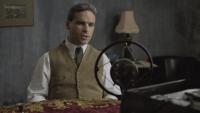
The film employs the narrative conceit that Frank Ryan (Dara Devaney) has agreed to record his life story for Hans Hartmann (Barry Barnes, inset).
Irish history, as recent public controversies about republican violence during the War of Independence have made clear, remains an ideological minefield. Against this background, making a film about one of the most controversial republicans of the last century, Frank Ryan, presents obvious challenges. Before the first scene of The enigma of Frank Ryan had been shot, our film had been denounced by an Irish Democrat article headlined ‘Film to slander Frank Ryan as Nazi collaborator’. The subject of three biographies, Ryan has long divided opinion. As a prominent IRA figure, leader of the short-lived but influential Republican Congress and most senior Irish officer within the International Brigades, he remains much admired within republican and left-wing circles. His legacy has been tainted, however, by the charge of collaboration (not least for those who point to his presence in wartime Germany as a broader indictment of the IRA’s alliance with Nazism).
 As is often the case, the key facts are well established but their interpretation remains disputed. Following his capture by pro-Franco Italian forces in Spain in 1938, Ryan was sentenced to death but his sentence was commuted to life imprisonment following an international campaign for clemency. Unable to secure Ryan’s freedom from Burgos jail long after the release of other International Brigade prisoners and the outbreak of World War II, the resourceful Irish minister to Spain, Leopold Kerney, turned to German intelligence (Abwehr) contacts in Franco’s Spain. Kerney was not alone in doing so: the IRA chief-of-staff, Seán Russell, recently arrived in Berlin from the United States, had also requested German support for Ryan’s release, as had two Abwehr experts on Ireland who had befriended Ryan during periods of study in Ireland.After Ryan’s ‘escape’ was authorised by Franco in July 1940, he was brought by Abwehr to Berlin, where he was persuaded to accompany Russell on a secret mission to Ireland. There is no evidence that Ryan had agreed to anything more compromising than an unconventional means of returning home. Russell, in contrast, had put in place an alliance between Nazism and the IRA based on realpolitik rather than ideological compatibility. Following Russell’s sudden death (the result of a perforated ulcer) as their U-boat neared the Irish coast, Ryan—who had no knowledge of the details of Russell’s mission—chose to return to Germany in order to preserve the link between republicanism and Germany, a decision he would come to regret. He was apparently motivated by the belief that, with a German invasion of Britain (or, many Irish republicans believed, a British pre-emptive invasion of Ireland) imminent, his presence there would facilitate an alliance that might bring about Irish unification. Hitler’s failure to invade Britain and his assault on the Soviet Union changed everything, however: it is this context that provides the starting point of our film, as an ill and disillusioned Ryan reflects on the events that have brought him to this juncture.
As is often the case, the key facts are well established but their interpretation remains disputed. Following his capture by pro-Franco Italian forces in Spain in 1938, Ryan was sentenced to death but his sentence was commuted to life imprisonment following an international campaign for clemency. Unable to secure Ryan’s freedom from Burgos jail long after the release of other International Brigade prisoners and the outbreak of World War II, the resourceful Irish minister to Spain, Leopold Kerney, turned to German intelligence (Abwehr) contacts in Franco’s Spain. Kerney was not alone in doing so: the IRA chief-of-staff, Seán Russell, recently arrived in Berlin from the United States, had also requested German support for Ryan’s release, as had two Abwehr experts on Ireland who had befriended Ryan during periods of study in Ireland.After Ryan’s ‘escape’ was authorised by Franco in July 1940, he was brought by Abwehr to Berlin, where he was persuaded to accompany Russell on a secret mission to Ireland. There is no evidence that Ryan had agreed to anything more compromising than an unconventional means of returning home. Russell, in contrast, had put in place an alliance between Nazism and the IRA based on realpolitik rather than ideological compatibility. Following Russell’s sudden death (the result of a perforated ulcer) as their U-boat neared the Irish coast, Ryan—who had no knowledge of the details of Russell’s mission—chose to return to Germany in order to preserve the link between republicanism and Germany, a decision he would come to regret. He was apparently motivated by the belief that, with a German invasion of Britain (or, many Irish republicans believed, a British pre-emptive invasion of Ireland) imminent, his presence there would facilitate an alliance that might bring about Irish unification. Hitler’s failure to invade Britain and his assault on the Soviet Union changed everything, however: it is this context that provides the starting point of our film, as an ill and disillusioned Ryan reflects on the events that have brought him to this juncture.
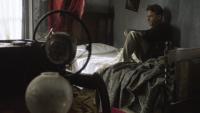
The starting point of the film—an ill and disillusioned Ryan reflects on the events that have brought him to Nazi Germany.
Our purpose here is not to defend the interpretation adopted by our film—viewers will make up their own minds on this—but to identify some of the issues involved in bringing such controversial stories to the screen, and to outline some of the methods we have used to communicate our complex story to a wider public. Bringing together an academic historian (and biographer of Ryan) and a film-maker who has made numerous historical documentaries, our collaboration forms part of a broader Arts and Humanities Research Council-funded project intended to explore the relationship between academic history and film.If writing Irish history is controversial, filming Irish history is generally more so—as was demonstrated by the reception of Neil Jordan’s Michael Collins (1996) and Ken Loach’s The wind that shakes the barley (2006). The strongest criticisms often emanate from academic historians and invariably focus on issues relating to bias and accuracy: historical films are criticised for not conveying the complexity of the past and for misrepresenting the historical record. Unease about the way film rides roughshod over matters of historical detail is compounded by an awareness that a growing number of people receive most of their information about the past from television and cinema rather than from books.Historians’ criticisms raise legitimate questions about the accuracy of filmic accounts of the past but often fail to appreciate the commercial, narrative and formal features of film and television production. In contrast to the academic monograph, which emphasises multiple perspectives carefully evaluated against the available evidence, film often tells a story from a single perspective and in a subjective and, on occasions, partisan manner. Much of the criticism of The wind that shakes the barley, for example, misses the obvious point that the film does not seek to depict the War of Independence in an impartial manner but rather from the point of view of an idealistic left-wing republican. That this is not how most people experienced or subsequently interpreted the conflict does not invalidate the perspective chosen by the film-maker: one suspects that concern about the power of the medium to shape popular understanding lies behind much of the vehemence of this criticism.The enigma of Frank Ryan eschews traditional aspects of the documentary, such as the ‘voice of God’ narration and the use of expert witnesses, which can often lead to a didactic, authoritative and expository tone emulating that of the academic historian. Instead, our ‘docu-drama’ approach combines fictive techniques, such as the use of re-enactment involving actors, art design and cinematography, with the extensive use of archival material (a feature of traditional documentary) to reconstruct a sense of the worlds through which Ryan moved. For example, we see Ryan in a radio studio broadcasting to frontline International Brigade troops, then we cut to an archive sequence of a propaganda loudspeaker system in the field from Joris Ivens’s 1937 film The Spanish earth. This approach places the film somewhere between the historical ‘live-action’ movie and the conventional documentary genre.
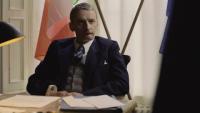
The militaristic Seán Russell (Frankie McCafferty)—a composite of several IRA figures with whom Ryan clashed during the 1930s.
This hybrid strategy is signalled at the outset: the film begins by employing the narrative conceit that Ryan has agreed to record his life story for Hans Hartmann, the head of the wartime radio service which broadcast Nazi propaganda to Ireland, enabling Ryan to relate his own life story in a series of flashbacks directly to the audience without the mediation of an omniscient narrator. The adoption of an inflected voiceover that has more in common with the ‘inner monologue’ found in fiction film-making intentionally destabilises the veracity of the narration, while creating a different sort of referential relation of voice to archival image than that found in the traditional television documentary.Our script takes liberties that no academic text would or should: characters are conflated (the militaristic Seán Russell is a composite of several IRA figures with whom Ryan clashed during the 1930s); dialogue is imagined; encounters are depicted for which there is scant evidence (Ryan, for example, is shown questioning German officials about the concentration camps); the dynamics of personal relationships are altered (greater emotional weight, for example, is attached to the relationship between Ryan and his lover Rosamond Jacob than the evidence permits, and Jacob in turn becomes a cipher for a feminist critique of republican masculine adventurism); and complex political debates (such as the clash between Irish nationalists and internationalists within the International Brigades) are condensed into emblematic scenes which, given the determinants of screen time, can merely hint at the complexity of the ideas involved.Does this make for bad history? For the scholarly historian—whose stock-in-trade is the careful evaluation of empirical evidence—the fact-based drama genre represents a challenge. How can the viewer be expected to know which events occurred and which have been invented? At what point does dramatic licence distort the fundamental historical issues at stake, or fatally compromise the critical value of a film as an engagement with history?The contributions of some historians to the debates that have followed screenings of our film—including a lively History Ireland Hedge School after the film’s screening at the Dublin International Film Festival (https://www.historyireland.com/ hedge/)—have focused on the many ways in which the film departs from the historical record. These sins of omission (both of context and detail) and of commission (falsification of the record) reflect a strong awareness by historians of the limitations of film in comparison to the academic text in matters of historical fidelity but a limited appreciation of the requirements and strengths of the medium. That this is often the default response of historians makes it difficult for non-specialists to discern between films that engage meaningfully with the substance of history and those that engage more with the genre and history of film than with the historical subject-matter they exploit for inspiration. Such responses, as James Chandler has recently observed, are hardly confined to Irish historians. In 2006 the American Historical Review reversed its decision to merge its film and book review sections on the grounds of its reviewers’ lack of expertise and interest in the medium of film other than as movie-goers:
‘The dominant approach of reviewers had been to assess the historical accuracy of a film, paying little attention to the specificity of film as a language or mode of representation (something which those with a deep interest in film are quick to point out). When historians review films, they usually write about what they know about—accuracy, verisimilitude, and pedagogical usefulness. These are not inconsiderable as commentary, but it is a far cry from what we expect from them in a book review.’
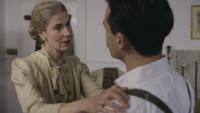
Greater emotional weight is attached to the relationship between Ryan and his lover Rosamond Jacob (Mia Gallagher) than the evidence permits, and Jacob in turn becomes a cipher for a feminist critique of republican masculine adventurism.
More radically, some historians’ criticisms of film suggest a limited appreciation of what the French philosopher Jacques Rancière terms the ‘poetics of history’—that is to say, the literary and figurative dimensions of historical writing, which, after all, originated as a literary endeavour bound by narrative and characterisation considerations as much as by ‘scientific’ method. Academic historians also grapple with evidential problems, truth claims and subject position: historians may arrive at incommensurable assessments of the documentary record yet are sometimes reluctant to engage with the critical implications of this. Film may flaunt its poetics more than the discipline of history but history also has its tropes and ellipses, and there are under-explored commonalities between both disciplines: the desire to communicate a story; the imposition of narrative structures in order to do so; and the use of empathy and historical imagination to convey a sense of the past and to tease out the import for the present.There will always be debate about the extent to which the past should be dramatised to tell a historical story to a popular audience, but in order to engage meaningfully with the medium historians should develop a greater awareness of the different ways in which film-makers deploy sources and construct narratives to achieve expressive and revelatory outcomes. One starting point might be an acceptance that film communicates with its audience in a very different way, and serves different purposes, than academic scholarship. Film-makers are also practitioners of history but they operate to a different set of rules, material restrictions and communicational imperatives. The ever-growing importance of film and television documentary as a source of knowledge about the past points to the need for greater engagement with film and television history by academic historians. Their guiding impulse need not be damage control: film does not have to be a second-rate means of communicating history. Its superior ability to deploy visual sources can contribute to historical understanding in ways that the text does not. For example, in a key scene in our film, when Ryan meets leading Nazi Dr Edmund Veesenmayer in Berlin, the potency of Nazi iconography makes an arresting case concerning Ryan’s status as a collaborator that the dialogue proceeds to undercut. Film’s dramatic appeal, its storytelling qualities and its ability to engage on an emotional level can vastly extend the reach and impact of historical knowledge. Historians, particularly younger historians, are increasingly willing to engage with history on screen—not merely by functioning as ‘talking heads’ to be edited into documentaries to provide authority for a narrative that the historian has little ability to influence but by more meaningful collaborations which may entail critical reflection on their own practices.
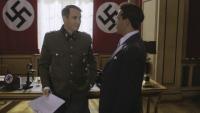
When Ryan meets leading Nazi Dr Edmund Veesenmayer (Ian Hughes) in Berlin, the potency of Nazi iconography makes an arresting case concerning Ryan’s status as a collaborator that the dialogue proceeds to undercut.
(All images: Glass Machine Productions)
Our collaboration has deployed a variety of means by which academic research might be more effectively communicated to a wider audience. An important principle is that historians and film-makers who address controversial subjects should be willing to engage with the public. Our film seeks to open a dialogue about Frank Ryan, his times and legacy. To that end, screenings of the film have been accompanied by public debates involving the film-maker, historians, political admirers of Ryan, and even the children of characters portrayed in the film. These debates are hosted on a website that makes available archival sources to allow people to interpret the historical evidence for themselves, as well as a body of interpretative resources that make explicit the extent to which aspects of the film are based on evidence, and offers guidance to those who want to learn more about the subject. Although it changes some of the detail of the past, we hope that our film does not mislead viewers about the fundamental historical and political issues raised by Ryan’s presence in Germany. While the film aspires to historical reliability, it also seeks to illuminate the inner core of his character and fate in a way that is different from, rather than inferior to, a scholarly text. We hope that we have cast some light on the enigma that was Frank Ryan. HI
Further reading:
D. Bell, ‘Documentary film and history’, in Documentary in a changing state: Ireland since the 1990s (Cork, 2012).J. Chandler, ‘Cinema, history, and the politics of style: Michael Collins and The wind that shakes the barley’, Field Day Review 7 (2011).F. McGarry, Frank Ryan (Dublin, 2010).http://www.qub.ac.uk/sites/frankryan/


















